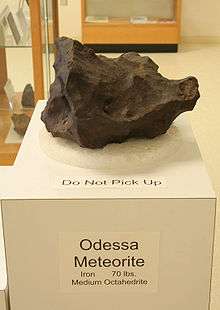Odessa Meteor Crater
| Odessa Meteor Crater | |
| National Natural Landmark | |
| Meteor Crater and museum | |
| Country | |
|---|---|
| State | |
| Region | Ector County |
| District | Permian Basin |
| Elevation | 930 m (3,051 ft) |
| Coordinates | 31°45′22″N 102°28′44″W / 31.7560°N 102.4788°WCoordinates: 31°45′22″N 102°28′44″W / 31.7560°N 102.4788°W [1] |
| Geology | Meteor Crater |
| Founded | U.S. National Natural Landmark |
| Date | 1965 |
| Management | Ector County |
 Sketch of geological cross section | |
| Website: | |
| Designated | 1965 |
The Odessa Meteor Crater is a meteorite crater in the southwestern part of Ector County, southwest of the city of Odessa of West Texas, United States. It is accessible approximately 3 miles (5 km) south of Interstate 20 at Exit 108 (Moss Road).[2] This is one of three impact crater sites found in Texas, the others being the older and much larger Sierra Madera crater and the Marquez crater.

The Handbook of Texas Online describes the Odessa meteor crater as the largest of several smaller craters in the immediate area that were formed by the impact of thousands of octahedrites (an iron metallic type) that fell in prehistoric times.[3]
The web site of the University of Texas of the Permian Basin (UTPB, Center for Energy and Economic Diversification), identifies five craters at the Odessa site and shows a distribution map of the meteorite fragments recovered from the area.[4] The recoveries have generally come from an area to the north and northwest of the main crater site, with only a few found to the south. They indicate that the structure of the main crater, because it was one of the earliest to be recognized and studied, is now used to name similar impact sites on a worldwide basis. Over 1500 meteorites have been recovered from the surrounding area over the years, the largest of which weighed approximately 300 pounds (135 kg), but excavations in the main crater confirm that there is no meteorite mass underground and probably never has been. The site has been designated as a National Natural Landmark by the National Park Service, and a small information area and nature trail has been set up on-site for a self-guided tour.
It is 168 meters (~550 feet) in diameter and the age is estimated to be around 63,500 years (Pleistocene or younger).[5] The crater is exposed to the surface, and was originally about 100 feet (30 meters) deep. Because of subsequent infilling by soil and debris, the crater is currently 15 feet (5 meters) deep at its lowest point, which provides enough relief to be visible over the surrounding plains, but does not offer the dramatic relief found at the more famous Meteor Crater in Arizona.
Still, the site offers an excellent opportunity to view a relatively uncommon impact feature close to a major transportation artery near a major city.
The crater itself and the museum curator, Tom Rodman, were featured in the June 1, 2013 broadcast of Bob Phillips's syndicated television series, Texas Country Reporter.[6]
See also
| Wikimedia Commons has media related to Odessa Meteor Crater. |
References
- ↑ "Feature Detail Report for: Odessa Meteor Crater". Geographic Names Information System (GNIS). USGS. November 30, 1979. Retrieved September 22, 2014.
- ↑ "Odessa". Earth Impact Database. University of New Brunswick. Retrieved 2008-12-30.
- ↑ Smith, Julia Cauble. "Meteor crater at Odessa". Handbook of Texas Online. Retrieved 5 November 2009.
- ↑ Anonymous. "Meteor Impact Structures". Center for Energy & Economic Diversification, The University of Texas of the Permian Basin. Retrieved 5 November 2009.
- ↑ Holliday, V.T., Kring, D.A., Mayer, J.H. and Goble, R.J. 2005. Age and effects of the Odessa meteorite impact, western Texas, USA. Geology 33(12):945-948.
- ↑ "Texas Country Reporter 2013 Episode Guide: Odessa Meteor Crater Museum". texascountryreporter.com. Archived from the original on April 15, 2009. Retrieved June 5, 2013.
External links
![]() Media related to Odessa Meteor Crater at Wikimedia Commons
Media related to Odessa Meteor Crater at Wikimedia Commons
- Odessa Meteor Crater and Museum website
- UTPB Center for Energy and Economic Diversifications, Odessa Meteor Craters
- Mindat.org - Odessa Craters, Odessa, Ector Co., Texas, USA
- Article about the crater
- Photos of West Texas and the Llano Estacado
- Video of the main crater site.

